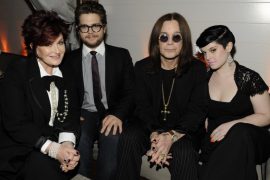Following up on an earlier post about the passing of Dick Clark: racial integration on the dance floor of American Bandstand happened a lot faster than I remembered.
Bill Harris at the Toronto Sun helped dig out the Sun story I wrote in 2003 about a visit to the Los Angeles set of American Dreams, a short-lived NBC series that was more or less an homage to the glory days of Clark ’s American Bandstand.
The nostalgic drama, which ran from 2002-05, was seen as an antidote to anxious, post-9/11 times. It hearkened back to a kinder, gentler America , the squeaky-clean world of the mid-’60s.
Those times, however, were a changin’. The series began in the fall of 1963. John Kennedy has been assassinated. The Civil Rights movement was on the march. Beatlemania was about to sweepAmerica .
The series, in executive producer Jonathan Price’s words, tried to hold a “a rear view mirror of history that says we made it through a difficult, horrible, wonderful, thrilling roller coaster in 1963 through 1969, ’70. We’re going to make it again.”
Those times, however, were a changin’. The series began in the fall of 1963. John Kennedy has been assassinated. The Civil Rights movement was on the march. Beatlemania was about to sweep
The series, in executive producer Jonathan Price’s words, tried to hold a “a rear view mirror of history that says we made it through a difficult, horrible, wonderful, thrilling roller coaster in 1963 through 1969, ’70. We’re going to make it again.”
 |
| The cast of NBC’s American Dreams |
Dick Clark’s slice of white bread Americana was faithfully re-created on the same Sunset-Gower studio back lot where many of the Frank Capra films of the ’30s were lensed. Extras dressed in short-brimmed fedoras, wool coats and other ’60s clothing were hired to walk among critics shuttled into the lot during that season’s TCA press tour. Beside us on the street were Ford Fairlanes and other cars from that era.
There was a record store on the lot where Beatle records and posters were shown to be crowding out the Motown and surf band chart busters. In a neat bit of casting, Art Garfunkel made a few appearances on the series as the owner of the record store.
Montreal-native Vanessa Lengies, a former Popular Mechanics For Kids host now seen as Sugar on the third season of Glee, played Bandstand dancer Roxanne Bojarski. She handed out chocolate “45s” to critics. Former NYPD Blue regular Gail O’Grady, who plays ’60s mom Helen Pryor, offered Tastycakes to writers filing through the interior set of the main family house.
There was a record store on the lot where Beatle records and posters were shown to be crowding out the Motown and surf band chart busters. In a neat bit of casting, Art Garfunkel made a few appearances on the series as the owner of the record store.
Montreal-native Vanessa Lengies, a former Popular Mechanics For Kids host now seen as Sugar on the third season of Glee, played Bandstand dancer Roxanne Bojarski. She handed out chocolate “45s” to critics. Former NYPD Blue regular Gail O’Grady, who plays ’60s mom Helen Pryor, offered Tastycakes to writers filing through the interior set of the main family house.
He pointed out all the gold records, pennants and other paraphernalia on the set and said they were exact duplicates of the ones he still had in his office.
American Dreamsdealt with the gradual integration of African Americans onto the Bandstand dance floor, a breakthrough that happened sooner in racially-mixed Philly than in other part of the United States or Canada . Clark recalled that the first black couple hit the dance floor in 1959 (Bandstand began in 1956) and that the transition went a lot smoother than the network originally feared.







